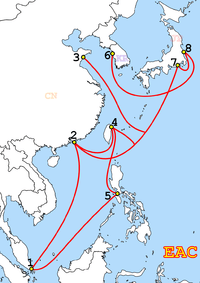EAC-C2C
EAC-C2C is a submarine telecommunications cable system interconnecting several countries in Asia, the Pacific, and the United States. It is a merger of the former EAC (East Asia Crossing) and C2C cable systems.[1] The merger occurred in 2007 by Asia Netcom, and the cable system is now owned/operated by Pacnet.[2] Pacnet was acquired by the Australian telecommunications company Telstra in 2015.

The EAC portion of the cable system includes:
- Changi, Singapore
- Tseung Kwan O, Hong Kong
- Qingdao, China (later extension)
- Bali, Taiwan
- Fangshan, Taiwan
- Capepisa, The Philippines
- Taean, South Korea
- Shima, Japan
- Ajigaura, Hitachinaka, Ibaraki, Japan
Length: 19,500 kilometers
Capacity: 160 Gbit/s - upgradeable to 2.5 Tbit/s
Technology: DWDM (dense wavelength-division multiplex)

The C2C portion of the cable system comprises three rings:
- C2C North Ring
- C2C South Ring
The landing points on each ring are as follows:
C2C North Ring

- Chung Hom Kok, Southern District, Hong Kong
- Nasugbu, Batangas Province, Philippines
- Fangshan, Pingtung County, Taiwan
- Danshui District, New Taipei City, Taiwan
- Nanhui District, Shanghai, China
- Pusan, South Korea
- Shima, Mie Prefecture, Japan
- Chikura, Chiba, Chiba Prefecture, Japan
C2C South Ring

EAC-C2C Merger
In 2007, Asia Netcom (now Pacnet) merged the EAC cable system and the C2C cable system into a single EAC-C2C cable system, spanning 36,800 kilometers between Japan, Korea, China, Taiwan, Hong Kong, the Philippines and Singapore, connecting 17 cable landing stations. EAC-C2C cable system becomes the most resilient submarine network in Asia region.[3]
References
- ↑ "Asia Netcom merges EAC with C2C". Telecom Asia. 2007-09-14. Retrieved 2014-06-28.
- ↑ "Laser Focus World: Lasers, Photonics, Optics News and Laser Technology Advances". Optoiq.com. Retrieved 2014-06-28.
- ↑ "EAC-C2C Submarine Cable System". Submarine Cable Networks. Retrieved 2012-02-23.